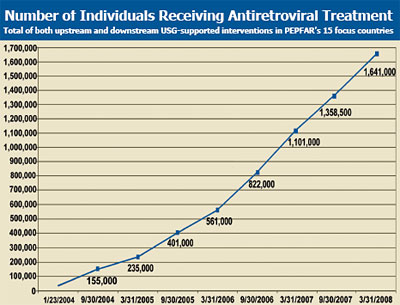|

The Power of Partnerships: Latest PEPFAR Results
U.S. Supports Treatment for Nearly 1.73 Million Globally Through Power of Partnerships
“The pandemic of HIV/AIDS can be defeated. The United States is taking the lead in this great effort, and we stand united with our international partners in combating this virus.”
-World AIDS Day 2007, Proclamation by the President of the United States of America
The U.S. President’s Emergency Plan for AIDS Relief (PEPFAR) is on target to achieve its ambitious goals of supporting treatment for two million people, prevention of seven million new infections, and care for 10 million people infected and affected by HIV/AIDS, including orphans and vulnerable children.
Latest Treatment Results
- Globally, PEPFAR supported life-saving antiretroviral treatment for approximately 1.73 million men, women and children as of March 31, 2008.
- Of this, PEPFAR supported life-saving antiretroviral treatment for more than 1.64 million people through bilateral programs in PEPFAR’s 15 focus countries in sub-Saharan Africa, Asia and the Caribbean.
- When President Bush announced PEPFAR, it was estimated that only 50,000 people were receiving treatment for HIV/AIDS in sub-Saharan Africa. Of those for whom PEPFAR supported treatment as of March 2008, nearly 1.68 million are in this region.
 |
By supporting the most comprehensive, evidence-based program in the world, targeting interventions based on the epidemiology of HIV infection in each country, PEPFAR has supported in the 15 focus countries:
Through March 31, 2008:
- Prevention of mother-to-child HIV transmission services for women during nearly 12.7 million pregnancies
- Antiretroviral prophylaxis for women in more than 1 million pregnancies
- Prevention of an estimated 194,000 infant infections
Through September 30, 2007:
- Care for more than 6.6 million, including care for more than 2.7 million orphans and vulnerable children
- Over 33 million counseling and testing sessions for men, women and children
|

The Power of Partnerships
- PEPFAR holds a unique place in the history of public health for its size and scope:
- In size, with a funding level of $18.8 billion across five years, it is the largest international health initiative in history dedicated to a single disease.
- In scope, it is the first large-scale effort to tackle a chronic disease in the developing world. And it moves beyond isolated efforts and pendulum swings that had led programs to focus on prevention or treatment or care for HIV/AIDS to sound public health that addresses all three through an integrated approach.
- The success of PEPFAR is firmly rooted in partnerships between the American people and the people of the countries in which we are privileged to serve — governments, non-governmental organizations including faith- and community-based organizations, the private sector, and groups of people living with HIV/AIDS.
|
Number of Individuals Receiving Antiretroviral Treatment as of March 31, 2008 |
| |
Downstream1 |
Upstream2 |
Total |
| Botswana3 |
0 |
94,900 |
94,900 |
| Cote d'Ivoire |
31,700 |
8,000 |
39,700 |
| Ethiopia |
97,100 |
0 |
97,100 |
| Guyana |
2,000 |
0 |
2,000 |
| Haiti |
14,900 |
200 |
15,100 |
| Kenya |
182,600 |
9,500 |
192,100 |
| Mozambique |
59,400 |
28,800 |
88,200 |
| Namibia |
48,000 |
4,800 |
52,800 |
| Nigeria |
149,100 |
13,400 |
162,500 |
| Rwanda |
30,400 |
22,000 |
52,400 |
| South Africa |
305,400 |
129,700 |
435,100 |
| Tanzania |
110,000 |
4,200 |
114,200 |
| Uganda |
102,000 |
29,200 |
131,200 |
| Vietnam |
11,800 |
0 |
11,800 |
| Zambia |
151,900 |
0 |
151,900 |
| Total Focus Countries |
1,296,300 |
344,700 |
1,641,000 |
| Other PEPFAR Countries4 |
87,000 |
-- |
87,000 |
| Total PEPFAR Countries |
1,383,300 |
344,700 |
1,728,000 |
NOTE: Numbers may be adjusted as attribution criteria and reporting systems are refined. Numbers above 100 are rounded to the nearest 100.
1 Included in downstream results are individuals reached through service delivery sites that are directly supported by USG interventions/activities (e.g. commodities, drugs, supplies, supervision, training or quality assurance) at the point of service delivery. Results are considered “downstream” if they can be associated with counts of uniquely identified individuals receiving services at unique program or service delivery points.
2Included in upstream results are estimates of individuals served as a result of the USG’s contribution to systems strengthening beyond those counted as receiving direct USG support. Systems strengthening includes support to national, regional, or local activities such as policy development; institutional capacity building; logistics; protocol or guideline development; advocacy; laboratory support; national or regional training; and national management information systems. Upstream support is vital to creating sustainable national systems.
3Botswana results are attributed to the National HIV/AIDS Program. Beginning in FY2005, following a consensus reached between the USG and the Government of Botswana, USG reports its contributions in the form of a single national figure for each relevant indicator.
4All USG bilateral HIV/AIDS programs are developed and implemented within the context of multi-sectoral national HIV/AIDS strategies, under the host country’s national authority. Programming is designed to reflect the comparative advantage of the USG within the national strategy, and it also leverages other resources, including both other international partner and private-sector resources. The number reported for other PEPFAR countries reflects the USG programs outside of the fifteen focus countries that provide direct support at the point of service delivery. Individuals outside of the focus countries receiving treatment as a result of the USG’s contribution to systems strengthening beyond those counted as receiving direct USG support are not included in this total.
|




 PDF version
PDF version